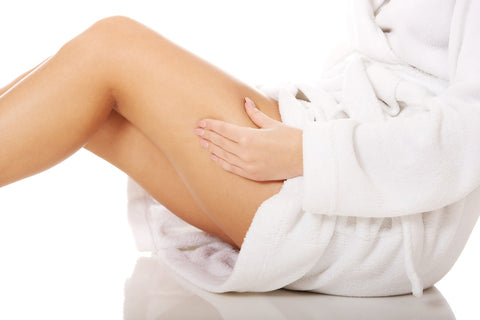How Do I Tell The Difference Between Fluid Retention and Cellulite?

And, then what do I do?
Unfortunately, many of us have one or both of these body issues. Know that not all “cottage cheese” skin is cellulitic. It may be chronic fluid retention. It is important to know the difference between cellulite and fluid because we care for these two issues very differently.
You can tell the difference between cellulite and fluid by the presence or absence of dimples. There are several ways to tell if you are dealing with cellulite or fluid:
- If you have what appears to be a dimple on the skin, lift the skin up gently above the dimple. If the dimple disappears, you are dealing with fluid. If the dimple is still visible, it is cellulite.
- You can do the “flick” test on the affected area. Gently flick the skin several times. If you see ripples, similar to dropping a pebble in pool of water, you are dealing with fluid.
- Lie on your back and raise your legs perpendicular to your body. If all the dimpling disappears, you are dealing with fluid.
- Feel the tissue by gently pressing on the skin. If the skin feels hard and dense, it is cellulite. If the skin feels soft, boggy or mushy, it is fluid.
Ninety percent of fluid retention is present just beneath the surface of the skin. There can be fluid present, with cellulite underneath. Many of us have a combination of the two. To improve the appearance of these conditions, the fluid needs to be addressed before the cellulite.
Fluid Retention
Fluid retention is a condition that most individuals will experience at one time or another. It is especially prevalent in females. Fluid retention can be acute, as during the menstrual cycle or due to medications. It can be chronic due to hereditary factors.
Factors contributing to fluid retention:
- High intake of table salt or sugar
- Heat
- Stress
- Hormonal imbalance
- Improper exercise
- Heredity
Stress can also play a major role in causing fluid retention. Chronic stress affects the adrenal glands, part of the endocrine (hormonal) system. In turn, the stress puts the whole hormonal system out of balance. The pituitary (also part of the endocrine system) is the gland that produces the hormone that controls fluid levels in the body and also tells the adrenals to activate when under stress.
Excessive refined sugar and salt intake can aggravate fluid conditions. Dairy and meat consumption can contribute to hormonal compromise because of the synthetic hormones being added to these foods. Nine out of 10 people have some level of hormonal imbalance. This affects both male and female.
Males are now developing cellulite and breast cancer, traditionally female disorders, as well as thyroid and obesity issues. All can be linked to diet. Compounding this condition is the heredity component.
One lifestyle behavior that can aggravate fluid retention is hot baths or showers. For many of us, taking a “hot” bath at the end of the day is a relaxing treat. The truth is that hot baths are very stimulating to the body and mind, which is the opposite of what we need when we’re trying to get to sleep or combating fluid retention.
For those prone to fluid retention, the hot water causes the tissue in the body to expand. This is a law of physics—heat expands, cold contracts. The space created by this expansion fills up with fluid. When our goal is to reduce fluid retention, we are accomplishing just the opposite because we are recreating the fluid with each bath/shower.
In order to reverse this, it is better to take a bath or shower with a water temperature of 93-97°F. This will cause a mild constriction of the tissue which forces the fluid out of the tissue and into the lymphatic system, thus reducing fluid. This is a major, but simple behavior to change.
Another lifestyle component that can aggravate fluid retention is choosing forms of exercise that build up heat in the body. Jogging, high impact aerobics and saunas (wet or dry) all create the same scenario as the hot baths/showers. The best forms of exercise are walking, swimming, low impact aerobics and weight training.
If there is a compromise in the lymphatic system, fluid can build up and become stagnant. Over time this stagnation, can lead to the “cottage cheese” appearance we associate with cellulite.
Better nutrition and supplementation are chief components to fight excess fluid. Algae are among the most potent forms of nutrition. They can be used as a whole food supplement and in skin and body care products as part of your personal care regimen. Remineralizing by increasing minerals and trace elements to your body is an important step to addressing fluid retention.
Professional treatments for fluid include seaweed wraps, hydrotherapy, lymphatic drainage and massage. A home program consisting of products incorporating dry body brushing, essential oils, and algae products will reinforce the remineralization on a daily basis, giving the body the fuel and tools it needs to repair itself.


Leave a comment